While in Chicago we had about two hours to tour the Art Institute of Chicago. Though they currently have a Picasso exhibit, we decided we didn't have time to see that as well as the rest of the museum.

We chose the rest of the museum and it did not disappoint.
There were many impressionist pieces in the permanent collection and they were displayed in a showroom bathed in natural light. Yay! Since photographs were allowed, I was able to capture a bit of what I saw that day.
 |
| Two Sisters (On the Terrace) by Pierre-Auguste Renoir, 1881. Oil on canvas. |
There's so much light in Renoir's work. In photography, light absorbs color. I wonder if that was his trick? Maybe some of you art majors or painter friends have a theory.
I'm tempted to do a piece explosive with color just to see what would happen...

As always, I am overjoyed when I find paintings of sewers, knitters, embroiderer, lacemakers, etc. And this museum had a good number of them; two were by Renoir.
Renoir had a blue and purple color party in this painting of a young girl sewing...
 |
| Young Girl Sewing by Pierre-Auguste Renoir, 1879. |
That being said, the preponderance of blue with undertones of violet, helps to bring the girl forward...
The following painting isn't a girl at all but a picture of Renoir's son at age 5 or so sewing. I've read that Renoir liked the color of his son's strawberry blond hair so much that he wouldn't allow him to cut until his son's school required it at age 7.
I remember when Jack was about four, he wanted to stitch so I gave him a hoop, needle and thread. He sat there for an hour or so making big stitches in all different colors.
It was the first and last time he has stitched.
Another portrait of a stitching woman is this one by Jacques Louis-David...
Madame Pastonet and Her Son by Jacque-Louis David, 1791/92. Oil on canvas.
|
It turns out that this painting isn't quite finished because it's believed that the political views of the artist were in conflict with his patron. Hence there is no needle in Madame's right hand and the background is incomplete.
|
You barely notice the babe in the cradle off to the right.
Next up is probably my favorite "needle" painting of the day, most likely because there is a bit of mystery to the work.
It's called Hesitation and the artist's suggestion of a title leaves the viewer to play a role in interpreting the story...
 |
| Hesitation (Madame Morteaux) by Alfred Stevens, 1867. |
This painting is by Alfred Stevens, a Belgian painter who spent most of his life in Paris. He was known for painting aristocratic women in elegant and enticing backgrounds. He often liked a bit of mystery, capturing his subject at a particular moment in time.
At first I thought this woman was listening at the door and her hesitation was her resistance to walk through it...But on further study, I noted the bit of pink paper that had been slipped under the door. Hmm...
Like Stevens' other works (see a gallery of his works here), the background detail is impressive as we are treated to a work table spilling over with tapestry wools, one skein having dropped to the floor as she stood up...
The detail is so well done that we can see that the needlepoint design is of Chinese influence, very appropriate for the late 19th century. We can also see the mess of thread ends on the back of the work.
It appears that there were quite a number of portraits painted in the 19th century showing girls/women who were working some type of needlework. Young aristocratic ladies were expected to be accomplished at many of the domestic arts, needlework being one of them and portraits showing their endeavors helped to sell that brand.
You can see hundreds of other examples of needlewomen in portraiture in Gail Sirna's book, In Praise of the Needlewoman. It's currently out-of-print but you can find used copies around the net. I love to use it as a guide for what paintings are housed in which museums...
Ok. I saved the best for last.
As I walked through one of the lesser galleries, I was stopped dead in my tracks by this painting...
 |
| Shoe Shop by Elizabeth Sparhawk-Jones, c. 1911. |
It was most certainly an Impressionist work but I had never seen it before. And, it was painted by a woman. Yet...
I had seen the Women Impressionists exhibit at the Legion of Honor a few years ago and never heard of this artist Elizabeth Sparhawk-Jones.
It turns out that she studied at the Pennsylvania Academy of Fine Arts in the early 20th century and began painting and selling her work as a teenager. Even though she was young, her paintings sold for about $50,000 in today's equivalent and she won many awards.
Following an exhibition in 1907, the New York Times dubbed her the "Find of the Year" after stating that her painting, The Porch, was the most unforgettable canvas in the show.
And check it out, there's even a woman embroidering in the foreground...
 |
| The Porch by Elizabeth Sparhawk-Jones, 1907 |
By 1913, a hereditary mental illness had claimed her and she wouldn't paint again until 20 years later. Though there wasn't even a wikipedia site for her, I was pleased to find a biography written in 2010 that I hope to read.
All of her early paintings are of contemporary, urban scenes of women shopping, reading, or caring for babies. To see more of her wonderful paintings, check out this blog post showing her work.
Well, that's it for my little art tour. Happy day everyone!






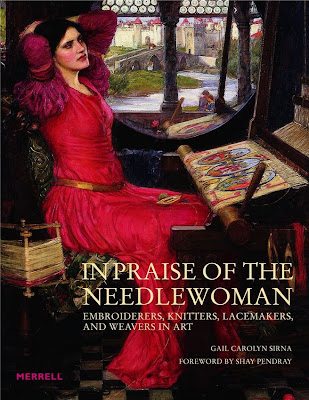



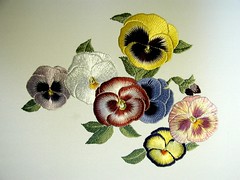
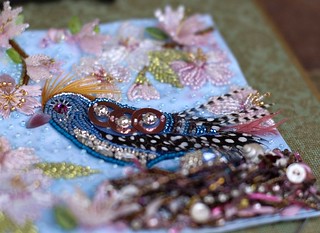
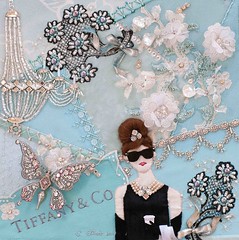
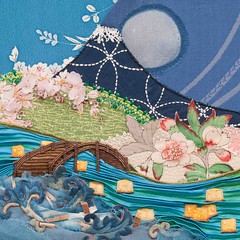
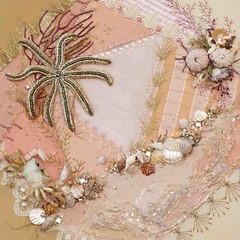












16 comments:
Always a treat to read posts of your journeys! You always manage to share such beautiful things and to teach me a thing or two.
What a fabulous, inspirational day! Now, what are you going to do with your riot of Impressionist colour?
You have inspired me today with this tour of art. I love going to the museum and visiting my favorites. Each visit allows me to see new things in each painting.
I had such a happy time reading your post and looking at all the sweet pictures..
Thank you for sharing x
How fun! I have very little education in art, but I do enjoy seeing beautiful artworks. These were fascinating!
My boys did a bit of stitching when they were little. You can see some on an old blog post of mine.
http://quiltwhangarei.blogspot.co.nz/search?q=hessian
One of my son's also has the same golden hair and I didn't cut it until he when to school either. As well as the wonderful colour, he had they most beautiful natural ringlets too. :-)
Don't you love actually seeing the paintings in the 'flesh' they look amazing in books etc but it's like a whole other magic is added when you can see them for real.
Thank you for this lovely and informative post. My husband and I love Impressionist paintings. These are all wonderful.
FlowerLady
I'm so glad you found time to visit the Art Institute, but then I thought you might.
xx, CArol
Thank you for this very rich post! In the 'mystery'...I observed not a piece of paper but one of those wedges used to keep a door propped open (expand the photo...what do you think?). The paper would make more sense but I wonder...
And Renoir's use of light is wonderful...especially combined with his clever use of complementary colours (red and blue dominate)...versus more neutral backgrounds...and his ability to pick up the precise red and blue and make it work without being over-powering. Wonderful!
Again, thank you so much!
Thank you for the tour I hope to get to Chicago one day and this will surely be one of my first stops! Also a very informative blog and had never heard of Elizabeth Sparhawk- Jones but will see what else I can read about her. Thank you again. Wendy
In a relatively short amount of 2 hours time you were really focused on some amazing paintings reflecting needlewomen. Thank you for sharing your wonderful museum tour. I adore hearing your views and insights from all your research you do. Happy Hearts...
Looking at your pictures it makes me realize how much I miss visiting Chicago - the museums, the night life, the planetarium, the lake, the zoo.....don't miss driving on Lake Shore.....even miss when all the cows were on display every where :)
Sandy
oh yes the light in Renoir`s materpieces is truly amazing.
Stunning artwork, thanks for the peek at perfection......amazed they let you take photos though, we wouldnt be allowed to over here.......thanks again for the feast of social history !
Monet once said that white (which I noticed a significant use of in the first Renoir in particular) harmonized up the other colors, as well as punching them up and making them more vibrant. Its a technique he also used in his gardens, with forget-me-not's, etc. Little dots of white among the colors brightens them up.
So very glad you made it to the Art Institute! We saw an awesome quilt exhibit there a few years back. It's a great place.
Post a Comment